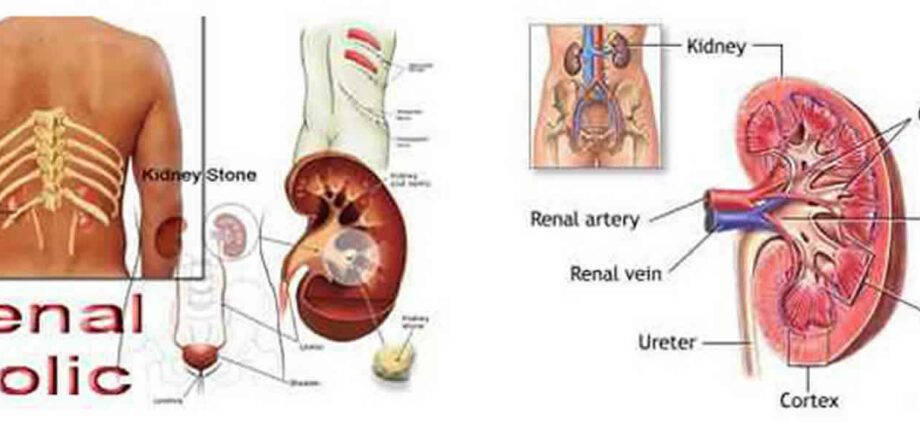Contents
Renal colic
Renal colic refers to a pain due to obstruction of the urinary tract. It manifests itself in pain Acute felt suddenly in the lumbar region, and it is due to a sudden increase in the pressure of the urine which can no longer flow.
Causes of renal colic
Renal colic is caused by an obstacle in the urinary tract that prevents the flow of urine.
In 3/4 of cases, the pain is triggered by a urolithiasis, more commonly called kidney stone.
Kidney stones (= small solid compounds like small pebbles of varying size, most often containing calcium or uric acid) form in the urinary tract, usually in the kidney or ureters (ducts that connect the kidneys to bladder).
When a stone is blocked in one of the ureters, it prevents or greatly slows down the passage of urine. However, the kidney continues to produce urine at a level too narrow for its passage. The flow of urine is then greatly slowed down, or even stopped, while the kidney continues to secrete. The hypertension generated by the accumulation of urine, upstream of the obstacle, causes intense pain.
Other causes of renal colic can be:
- inflammation of the ureter (= ureteritis due to tuberculosis, a history of irradiation),
- a tumor of the kidney tract,
- a pregnancy whose volume compresses a ureter,
- lymph nodes,
- fibrosis of the area,
- pelvic tumor, etc.
Risk factors for renal colic
The formation of these stones can be favored by various factors:
- upper urinary tract infections,
- dehydration,
- diet too rich in offal and cold meats,
- family history of lithiasis,
- anatomical malformations of the kidney,
- certain pathologies (hyperparathyroidism, gout, obesity, diabetes, chronic diarrhea, sponge medullary kidney, renal tubular acidosis type 1, Crohn’s disease, renal failure, hypercalciuria, cystinuria, sarcoidosis…).
Sometimes the risk of renal colic is increased by the taking certain medications.
The cause of renal colic can remain unknown and it is called idiopathic lithiasis.
Symptoms of renal colic
La pain occurs suddenly in the lumbar region, most often in the morning and / or at night. She is felt on one side, in the affected kidney It can extend from the back to the flank and to the stomach, groin and typically, this pain radiates to the external genitalia.
The pain varies in intensity but experiences particularly acute peaks. A dull ache frequently persists between each crisis episode, the duration of which can range from ten minutes to a few hours.
The pains are sometimes accompanied by digestive disorders (nausea, vomiting, bloating) or urinary disorders (frequent or sudden urges to urinate). The presence of blood in the urine is relatively common. Restlessness and anxiety are also often observed.
On the other hand, the general condition is not altered and there is no fever.
What to do in case of renal colic?
Due to the intensity of the pain, the renal colic attack falls under themedical emergency : It is important to contact a doctor as soon as symptoms appear. The therapeutic management is carried out according to the degree of gravity, but the priority remains whatever happens to relieve the pain and remove the obstacle.
The medical treatment of renal colic due to kidney stones, consists of injecting, antispasmodics and especially non-steroidal anti-inflammatory drugs, alpha blockers and calcium channel blockers. Morphine can also be used as a pain reliever.
Limit water intake, less than 1 liter per 24 hours: this could increase the pressure in the kidneys as long as the urinary tract remains blocked.
In 10 to 20% of cases, surgery is necessary when it comes to renal colic due to a calculus.1
How to prevent renal colic?
It is possible to reduce the risks on a daily basis by regular and sufficient hydration (1,5 to 2 liters of water per day) as this helps to dilute the urine and reduce the risk of stone formation.
Prevention mainly concerns people who have already suffered from
renal colic.
Depending on the cause of renal colic, it is treated.
If the cause of colic is a kidney stone problem, dietary measures are recommended, they depend on the nature of the stones already observed in each person. A preventive treatment of stones can also be implemented.
Complementary approaches to treat renal colic
Phytotherapy
The use of plants with diuretic properties makes it possible to increase the volume of urine and thus prevent the formation of kidney stones responsible for renal colic.
We can in particular turn to burdock, borage, blackcurrant, mate, nettle, dandelion, horsetail, elderberry or tea.
Warning: these plants are more for preventive purposes. They are therefore not suitable in the event of an acute crisis.
Homeopathy
- Prevention :
- for calculations of phosphates and oxalates, we recommend Oxalicum acidum in 5 CH at the rate of 3 granules three times a day,
- for kidney stones accompanied by albuminuria, Formica rufa at the same dosage is recommended.
- In anticipation of renal colic and pain: dilute 5 CH granules of Belladonna, Berberis vulgaris, Lycopodium and Pareira brava in spring water and drink throughout the day.
- In case of difficulty urinating: take 3 granules of Sarsaparilla three times a day.
- In the event of chronic renal colic (the volume of urine varies constantly): opt for Berberis vulgaris by respecting the same dosage.
- In field treatment to avoid recurrence:
- 5 granules per day of a mixture at 200 K to be made in a pharmacy composed of Calcarea carbonica, Collubrina and Lycopodium,
- in the case of phosphate stones, take Calcarea phosphoricum or Phosphoricum acidum (same dilution, same dosage).










